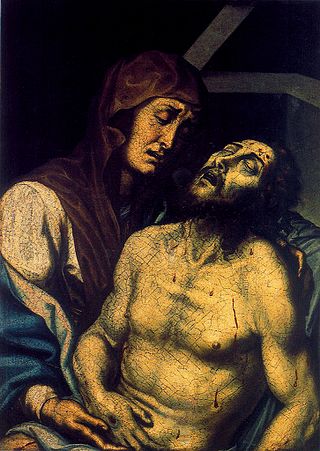
Matera is a city and the capital of the Province of Matera in the region of Basilicata, in Southern Italy. With a history of continuous occupation dating back to the Palaeolithic, it is renowned for its rock-cut urban core, whose twin cliffside zones are known collectively as the Sassi.

The Basilica dei Santi Giovanni e Paolo, known in Venetian as San Zanipolo, is a Catholic minor basilica and Dominican conventual church in the Castello sestiere of Venice, Italy.

Cosenza is a city located in Calabria, Italy. The city centre has a population of approximately 70,000, while the urban area counts more than 200,000 inhabitants. It is the capital of the province of Cosenza, which has a population of more than 700,000. The demonym of Cosenza in English is Cosentian.

Pomarico is a small town of 4500 inhabitants in Southern Italy, in the region Basilicata. It is about 30 kilometres (19 mi) from Matera, the capital of the province to which Pomarico belongs.

Bernalda is a town and comune in the province of Matera, in the Southern Italian region of Basilicata. The frazione of Metaponto is the site of the ancient city of Metapontum.

Grassano is a town and comune in the province of Matera, in the southern Italian region of Basilicata. It is located between the Bradano and Basento rivers at an elevation ranging from about 150 to 576 metres above sea level. The town proper is 43 kilometres (27 mi) from Matera and 59 kilometres (37 mi) from the regional capital, Potenza.

working
Salandra is a town and comune in the province of Matera, in the Southern Italian region of Basilicata.

San Mauro Forte is a town and comune in the province of Matera, in the Southern Italian region of Basilicata.
Stigliano is a town and comune in the province of Matera, in the Basilicata region of southern Italy.

Paola is an Italian comune of 15,408 inhabitants in the province of Cosenza in Calabria.
Santa Maria a Vico is a comune (municipality) in the Province of Caserta in the Italian region Campania, located about 30 kilometres (19 mi) northeast of Naples and about 13 kilometres (8 mi) southeast of Caserta.

San Domenico Maggiore is a Gothic, Roman Catholic church and monastery, founded by the friars of the Dominican Order, and located in the square of the same name in the historic center of Naples.

Sant'Anna dei Lombardi,, and also known as Santa Maria di Monte Oliveto, is an ancient church and convent located in piazza Monteoliveto in central Naples, Italy. Across Monteoliveto street from the Fountain in the square is the Renaissance palace of Orsini di Gravina.

San Pietro Martire is a Roman Catholic church in Naples, Italy. It is located directly across from the principal building of the University of Naples on the main street, Corso Umberto corner with Via Porta di Massa, near the port area. In the piazza in front of the church is a statue of Ruggero Bonghi.

Santa Caterina a Formiello is a church in Naples, in southern Italy, located at the extreme eastern end of the old historic center of the city, on Via Carbonara and Piazza Enrico de Nicola, near the gate called Porta Capuana. The term Formiello comes from the forms or containers for water spouts found in the convent. Diagonally across the street and South is the Fontana del Formiello against the rear wall of the imposing Castel Capuano.

Giovanni De Gregorio, known as il Pietrafesa called thus after the ancient name of the place of origin, Satriano, the ancient Pietrafesa. Giovanni De Gregorio, or Pietrafesa, was a Lucan painter. Active in the Kingdom of Naples between 1608 and 1653, he was a representative of the Neapolitan school. He was an Italian painter of the Baroque period. He painted an altar-piece of the Assumption of the Virgin Mary for the chapel of the convent of Marsico Nuovo.

The Church of Saint Mary of Pity is a Baroque church of Palermo. It is located at the corner of Via Alloro and Via Torremuzza in the quarter of the Kalsa, within the historic centre of Palermo.

The Sanctuary of the Virgin of Taburnus, also known as Sanctuary of Saint Mary of Mount Taburno, is a religious structure built at the end of the 15th century at the foot of Mount Taburno. It is located in the comune of Bucciano, in the province of Benevento of Southern Italy. For more than two hundred years it was used by Dominican friars.

Real Monasterio de Santo Tomás is a monastery of the Catholic Monarchs of Spain in Gothic style in Ávila, Spain. It was founded in 1482, as a Dominican convent to honour Saint Thomas Aquinas. It became the burial place of John, Prince of Asturias.




















